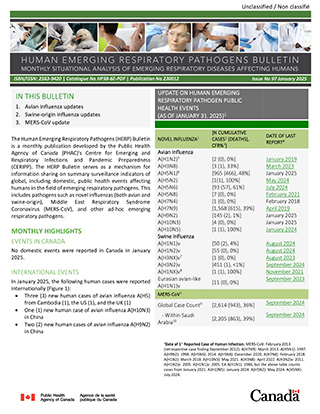Human emerging respiratory pathogens bulletin: Issue 97, January 2025
Download in PDF format
(1.2 MB, 5 pages)
Organization: Public Health Agency of Canada
Date published: 2025-02-11
Cat.: HP38-6E-PDF
ISBN: 2563-9420
Pub.: 230012
Monthly situational analysis of emerging respiratory diseases affecting humans (data to January 31, 2025).
In this bulletin
- Avian influenza updates
- Swine influenza updates
- Middle East respiratory syndrome coronavirus (MERS-CoV) update
| Novel influenzaFootnote 1 | Cumulative Case CountFootnote 2 | Deaths | Case Fatality Rate %Footnote 3 | Date of Last ReportFootnote 4 |
|---|---|---|---|---|
| Avian Influenza | ||||
| A(H1N2)Footnote 5 | 2 | 0 | 0% | January 2019 |
| A(H3N8) | 3 | 1 | 33% | March 2023 |
| A(H5N1)Footnote 6 | 965 | 466 | 48% | January 2025 |
| A(H5N2) | 1 | 1 | 100% | May 2024 |
| A(H5N6) | 93 | 57 | 61% | July 2024 |
| A(H5N8) | 7 | 0 | 0% | February 2021 |
| A(H7N4) | 1 | 0 | 0% | February 2018 |
| A(H7N9) | 1,568 | 615 | 39% | April 2019 |
| A(H9N2) | 145 | 2 | 1% | January 2025 |
| A(H10N3) | 4 | 0 | 0% | January 2025 |
| A(H10N5) | 1 | 1 | 100% | January 2024 |
| Swine Influenza | ||||
| A(H1N1)v | 50 | 2 | 4% | August 2024 |
| A(H1N2)v | 55 | 0 | 0% | August 2024 |
| A(H3NX)vFootnote 7 | 1 | 0 | 0% | August 2023 |
| A(H3N2)v | 451 | 1 | <1% | September 2024 |
| A(H1NX)vFootnote 8 | 1 | 1 | 100% | November 2021 |
| Eurasian avian-like A(H1N1)v | 11 | 0 | 0% | September 2023 |
| MERS-CoVFootnote 1 | ||||
| Global Case CountFootnote 9 | 2,614 | 943 | 36% | September 2024 |
| - Within Saudi ArabiaFootnote 10 | 2,205 | 863 | 39% | September 2024 |
|
||||
The Human Emerging Respiratory Pathogens (HERP) Bulletin is a monthly publication developed by the Public Health Agency of Canada (PHAC)'s Centre for Emerging and Respiratory Infections and Pandemic Preparedness (CERIPP). The HERP Bulletin serves as a mechanism for information sharing on summary surveillance indicators of global, including domestic, public health events affecting humans in the field of emerging respiratory pathogens. This includes pathogens such as novel influenzas (both avian and swine-origin), Middle East Respiratory Syndrome Coronavirus (MERS-CoV), and other ad-hoc emerging respiratory pathogens.
Monthly Highlights
Events in Canada
No domestic events were reported in Canada in January 2025.
International Events
In January 2025, the following human cases were reported internationally (Figure 1):
- Three (3) new human cases of avian influenza A(H5) in Cambodia (1), the US (1), and the UK (1)
- One (1) new human case of avian influenza A(H10N3) in China
- Two new human cases of avian influenza A(H9N2) in China
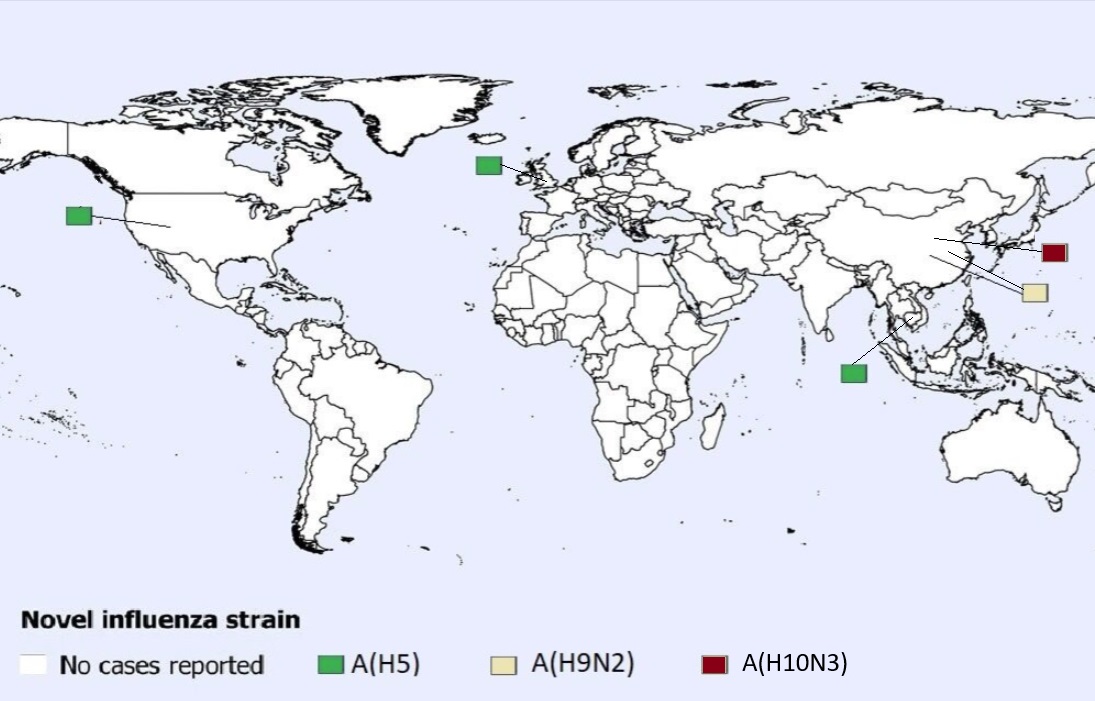
Figure 1 : Descriptive text
- Three (3) A(H5) cases were reported in Cambodia (1), the United States (1), and the UK (1).
- One (1) A(H10N3) case was reported in China.
- Two (2) A(H9N2) cases were reported in China.
Note: Map was prepared by CERIPP using data from the latest WHO Event Information Site (EIS) postings. This map reflects data available through these publications as of January 31, 2025.
Avian influenza updates
Avian influenza A(H5N1)
In January 2024, a total of three (3) new human cases of avian influenza A(H5N1), or A(H5) presumed to be A(H5N1), were reported, in Cambodia (1), the US (1), and the UK (1).
The case in Cambodia was reported in a 28-year-old male in Kampong Cham Province. He experienced illness onset on January 1, 2025 and was hospitalized on January 7, 2025. He was provided with oseltamivir, but ultimately died. This case guarded a farm in his village that reported sick poultry and he raised poultry for family consumption. No secondary cases were identified.
The case in the US was detected in a child in California. The case started experiencing mild illness on December 13, 2024, did not require hospitalization, and has since fully recovered. The exposure source is currently unknown; however, no secondary cases were reported.
The last case reported in January 2025 was reported in the West Midlands region of the UK. The case was infected on a farm where they had exposure to infected birds. The case was last reported as well and admitted to a High Consequence Infectious Disease (HCID) unit. No human-to-human transmission of this virus was observed.
Since 2022, 103 human cases of avian influenza A(H5N1), or A(H5) presumed to be A(H5N1), were reported worldwide (2022: n=6, 2023: n=13, 2024: n=81, 2025: n=3) (Figure 2). There are ten (10) known fatalities among cases reported in this time period (Figure 3).
In Canada, A(H5N1) detections associated with the current A(H5N1) clade 2.3.4.4b epizootic have been reported in domestic, backyard, and wild bird populations, as well as other animal species. Highly pathogenic avian influenza A(H5N1) has not been detected in Canada in dairy cattle, other livestock, or in raw milk. One (1) domestically acquired human A(H5N1) infection was reported in November 2024 and one travel-associated human A(H5N1) infection was reported in a Canadian resident returning from travel in China in 2014.
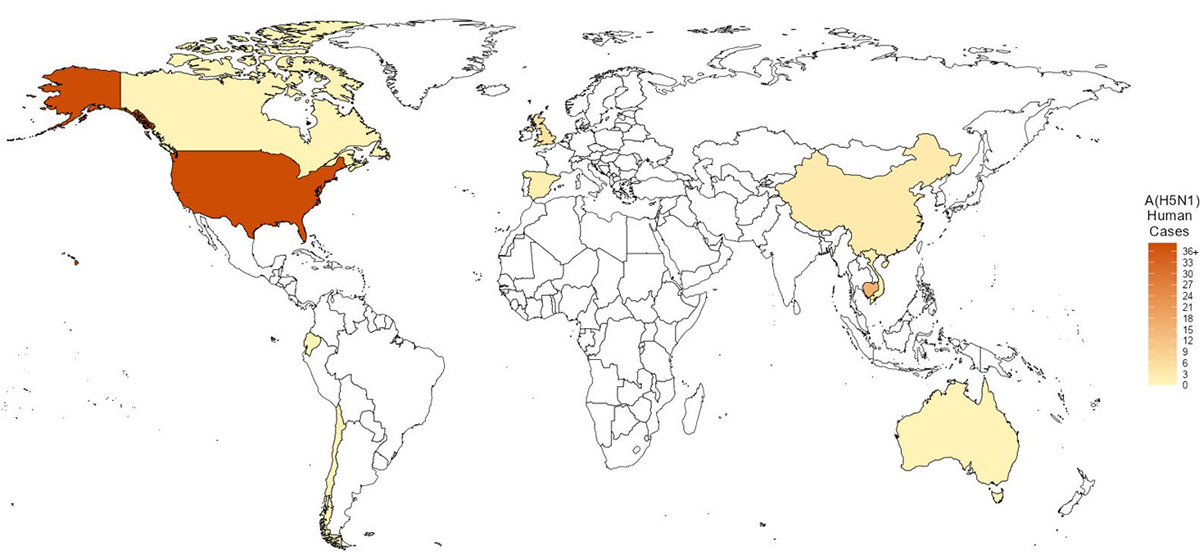
Figure 2 : Descriptive text
- One (1) case was reported out of Australia.
- One (1) case was reported out of Canada
- Seventeen (17) cases were reported out of Cambodia.
- One (1) case was reported out of Chile.
- Three (3) cases were reported out of China.
- One (1) case was reported out of Ecuador.
- Two (2) cases were reported out of Spain.
- Six (6) cases were reported out of the United Kingdom.
- Sixty-eight (68) cases were reported out of the United States of America.
- Three (3) cases were reported out of Vietnam.
Note: Map was prepared by CERIPP using data from the WHO EIS postings, the US CDC's Health Alert Network (HAN), and WHO cumulative case counts. This map reflects data available as of January 31, 2025. A(H5) cases reported in the US that are presumed to be A(H5N1) were also included.
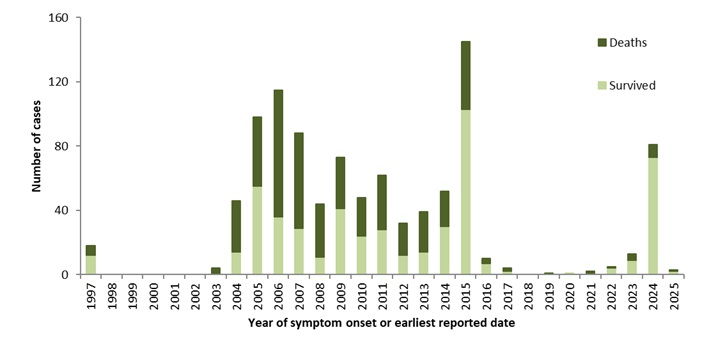
Figure 3 : Descriptive text
| Number of Cases | Deaths | Survived | |
|---|---|---|---|
| 1997 | 18 | 6 | 12 |
| 1998 | 0 | 0 | 0 |
| 1999 | 0 | 0 | 0 |
| 2000 | 0 | 0 | 0 |
| 2001 | 0 | 0 | 0 |
| 2002 | 0 | 0 | 0 |
| 2003 | 4 | 4 | 0 |
| 2004 | 46 | 32 | 14 |
| 2005 | 98 | 43 | 55 |
| 2006 | 115 | 79 | 36 |
| 2007 | 88 | 59 | 29 |
| 2008 | 44 | 33 | 11 |
| 2009 | 73 | 32 | 41 |
| 2010 | 48 | 24 | 24 |
| 2011 | 62 | 34 | 28 |
| 2012 | 32 | 20 | 12 |
| 2013 | 39 | 25 | 14 |
| 2014 | 52 | 22 | 30 |
| 2015 | 145 | 42 | 103 |
| 2016 | 10 | 3 | 7 |
| 2017 | 4 | 2 | 2 |
| 2018 | 0 | 0 | 0 |
| 2019 | 1 | 1 | 0 |
| 2020 | 1 | 0 | 1 |
| 2021 | 2 | 1 | 1 |
| 2022 | 5 | 1 | 4 |
| 2023 | 13 | 4 | 9 |
| 2024 | 81 | 8 | 73 |
| 2025 | 3 | 1 | 2 |
Note: Graph was prepared by CERIPP using data from the WHO EIS postings, the US CDC's Health Alert Network (HAN), and WHO cumulative case counts. This graph reflects data available as of January 31, 2025. A(H5) cases reported in the US that are presumed to be A(H5N1) were also included.
Avian influenza A(H5N2)
The most recent human case of avian influenza A(H5N2) was reported in May 2024 from Mexico.
This was the first ever detected human case of A(H5N2). Since only one human case of A(H5N2) has been reported to date and the availability of clinical information is limited, the full spectrum of disease is unknown.
Avian influenza A(H5N6)
The most recent human case of avian influenza A(H5N6) was reported in July 2024 from China.
Since January 2021, 67 cases of avian influenza A(H5N6) have been reported globally (2021: n=32, 2022: n=25, 2023: n=5, 2024: n=4) (Figure 4); all but one case (2021, Lao PDR) were reported in China. Since the emergence of this virus in 2014, a total of 93 laboratory-confirmed human cases of avian influenza A(H5N6), including at least 57 deaths, have been reported globally (CFR: 61%). No cases have been reported in Canada.
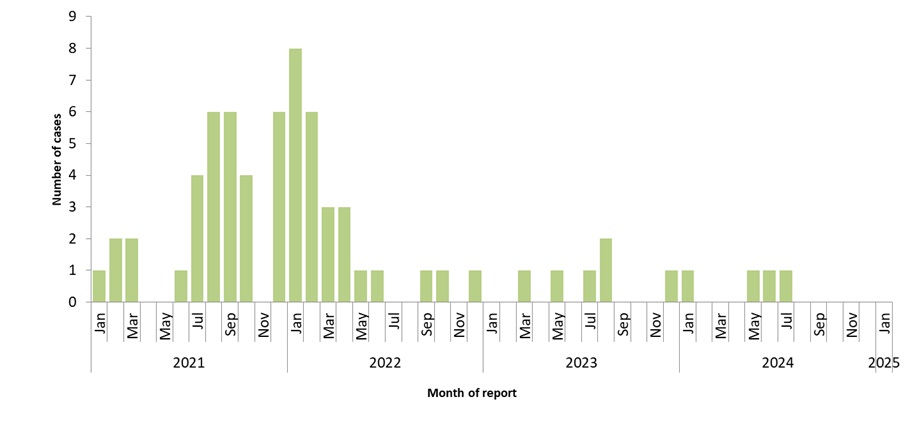
Figure 4 : Descriptive text
| Month | Cases | |
|---|---|---|
| 2021 | Jan | 1 |
| Feb | 2 | |
| Mar | 2 | |
| Apr | 0 | |
| May | 0 | |
| June | 1 | |
| July | 4 | |
| Aug | 6 | |
| Sep | 6 | |
| Oct | 4 | |
| Nov | 0 | |
| Dec | 6 | |
| 2022 | Jan | 8 |
| Feb | 6 | |
| Mar | 3 | |
| Apr | 3 | |
| May | 1 | |
| June | 1 | |
| July | 0 | |
| August | 0 | |
| Sep | 1 | |
| Oct | 1 | |
| Nov | 0 | |
| Dec | 1 | |
| 2023 | Jan | 0 |
| Feb | 0 | |
| Mar | 1 | |
| Apr | 0 | |
| May | 1 | |
| June | 0 | |
| July | 1 | |
| August | 2 | |
| Sep | 0 | |
| Oct | 0 | |
| Nov | 0 | |
| Dec | 1 | |
| 2024 | Jan | 1 |
| Feb | 0 | |
| Mar | 0 | |
| Apr | 0 | |
| May | 1 | |
| June | 1 | |
| July | 1 | |
| August | 0 | |
| Sep | 0 | |
| Oct | 0 | |
| Nov | 0 | |
| Dec | 0 | |
| 2025 | Jan | 0 |
Note: Graph was prepared by CERIPP using data from the WHO EIS postings and the Hong Kong Centre for Health Protection (CHP) press releases. This graph reflects data available as of January 31, 2025.
Avian influenza A(H9N2)
Two new human cases of avian influenza A(H9N2) were reported in January 2025 in China. There is no known epidemiological link between the two cases. The first case is an 8-year-old from Hubei Province who developed illness on November 27, 2024. The second case is a 1-year-old from Chongqing City who developed illness on December 13, 2024. Both cases were female and experienced mild symptoms after exposure to poultry. No secondary cases were identified for either case.
These two (2) cases are the first reported in 2025. In 2024, 21 human cases of avian influenza A(H9N2) were reported worldwide, from China (18), India (1), Vietnam (1), and Ghana (1). Since the emergence of avian influenza A(H9N2) in the human population in 1998, 145 cases have been reported worldwide, with a CFR of approximately 1%. No cases have been reported in Canada.
Avian influenza A(H10N3)
In January 2025, one (1) new human case of avian influenza A(H10N3) was reported in China. The case, a 23-year-old female with obesity, is from Guangxi Zhuang Autonomous Region. She experienced illness onset on December 12, 2024 and was hospitalized on December 19, 2024 with severe pneumonia. She was treated with oseltamivir and at the time of last report was hospitalized in a stable condition. Prior to illness onset, the case was exposed to freshly slaughtered poultry at the supermarket where she worked. No secondary cases have been reported. Samples from close contacts and the environment tested negative for A(H10N3).
Since the emergence of this virus in the human population in 2021, 4 cases have been reported, all from China (May 2021: n=1, August 2022: n=1, April 2024: n=1; January 2025: n=1). The CFR is 0%; however, all human cases of A(H10N3) that have been detected to date experienced severe illness. With only 4 human cases to date, the full spectrum of disease is highly uncertain.
Swine influenza updates
Swine origin influenza A(H1N1)v
The most recent human cases of swine origin influenza A(H1N1)v were reported in August 2024 from the US (1) and Vietnam (1).
A total of 50 human cases of A(H1N1)v have been reported globally since 2005, with a 4% CFR. Two A(H1N1)v detections have been reported in Canadian residents since reporting began in 2005, with the first case reported in Ontario in September 2012 and the second case reported in Manitoba in April 2021 (see HERP Bulletin no 52).Swine origin influenza A(H1N2)v
The most recent human case of swine origin influenza A(H1N2)v was reported in August 2024 from the US.
A total of 55 human cases of swine origin influenza A(H1N2)v have been reported globally since 2005, with a 0% CFR. Three swine origin influenza A(H1N2)v detections have been reported in Canadian residents since reporting began in 2005. The first case was reported in Alberta in October 2020 (see HERP Bulletin no 46), the second case was reported in Manitoba in April 2021 (see HERP Bulletin no 52) and the latest case in Canada was reported in November 2021 in Manitoba (see HERP Bulletin no 59).Swine origin influenza A(H3N2/H3NX)v
The most recent human cases of swine origin influenza A(H3N2)v were reported in September 2024 from the US.
Globally, 451 swine origin influenza A(H3N2)v cases have been reported since 2005, with <1% CFR. Four human cases of swine origin influenza A(H3N2)v have been reported in Canada since 2005. The first case of A(H3N2)v in Canada was reported in Ontario in 2005. This was followed by a second case in Ontario in 2016, a third case in Manitoba in June 2021 (see HERP Bulletin no 54), and a fourth case in Saskatchewan in July 2024 (see HERP Bulletin no 91).Middle East respiratory syndrome coronavirus (MERS-CoV) update
The most recent human case of MERS-CoV was reported in September 2024 from the Kingdom of Saudi Arabia.
According to the WHO, 2,614 laboratory-confirmed cases of MERS-CoV, including 943 deaths, have been reported globally since reporting began in 2012 (CFR: 36%) (Figure 5). No cases have ever been reported in Canada.
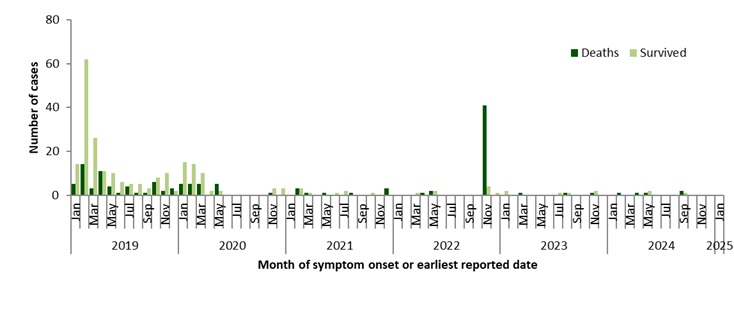
Figure 5 : Descriptive text
| Deaths | Survived | ||
|---|---|---|---|
| 2019 | Jan | 5 | 14 |
| Feb | 14 | 62 | |
| Mar | 3 | 26 | |
| Apr | 11 | 11 | |
| May | 4 | 10 | |
| June | 1 | 6 | |
| July | 4 | 5 | |
| Aug | 1 | 5 | |
| Sep | 1 | 3 | |
| Oct | 6 | 8 | |
| Nov | 2 | 10 | |
| Dec | 3 | 2 | |
| 2020 | Jan | 5 | 15 |
| Feb | 5 | 14 | |
| Mar | 5 | 10 | |
| Apr | 0 | 2 | |
| May | 5 | 2 | |
| June | 0 | 0 | |
| July | 0 | 0 | |
| Aug | 0 | 0 | |
| Sep | 0 | 0 | |
| Oct | 0 | 0 | |
| Nov | 1 | 3 | |
| Dec | 0 | 3 | |
| 2021 | Jan | 0 | 0 |
| Feb | 3 | 3 | |
| Mar | 1 | 1 | |
| Apr | 0 | 0 | |
| May | 1 | 0 | |
| June | 0 | 1 | |
| July | 0 | 2 | |
| Aug | 1 | 0 | |
| Sep | 0 | 0 | |
| Oct | 0 | 1 | |
| Nov | 0 | 0 | |
| Dec | 3 | 0 | |
| 2022 | Jan | 0 | 0 |
| Feb | 0 | 0 | |
| Mar | 0 | 1 | |
| Apr | 1 | 0 | |
| May | 2 | 2 | |
| June | 0 | 0 | |
| July | 0 | 0 | |
| Aug | 0 | 0 | |
| Sep | 0 | 0 | |
| Oct | 0 | 0 | |
| Nov | 41 | 4 | |
| Dec | 0 | 1 | |
| 2023 | Jan | 0 | 2 |
| Feb | 0 | 0 | |
| Mar | 1 | 1 | |
| Apr | 0 | 0 | |
| May | 0 | 0 | |
| June | 0 | 0 | |
| July | 0 | 1 | |
| Aug | 2 | 1 | |
| Sep | 0 | 0 | |
| Oct | 0 | 0 | |
| Nov | 1 | 2 | |
| Dec | 0 | 0 | |
| 2024 | Jan | 0 | 0 |
| Feb | 1 | 0 | |
| Mar | 0 | 0 | |
| Apr | 1 | 0 | |
| May | 1 | 2 | |
| June | 0 | 0 | |
| July | 0 | 0 | |
| Aug | 0 | 0 | |
| Sep | 2 | 1 | |
| Oct | 0 | 0 | |
| Nov | 0 | 0 | |
| Dec | 0 | 0 | |
| 2025 | Jan | 0 | 0 |
Note: Graph was prepared by CERIPP using data from the WHO Disease Outbreak News (DON) and Saudi Arabia's Ministry of Health. This graph reflects data available as of January 31, 2025. The data integrates CERIPP real-time reporting with WHO DON retrospective reporting of MERS-CoV cases and deaths. In November 2022, the WHO published a DON article that updated their counts with retrospective cases and deaths, which resulted in an increase of an additional 5 cases and 41 deaths compared to their previous MERS-CoV-related DON. In August 2023, the WHO published a DON article with case information for three retrospective MERS-CoV cases and two deaths. These three cases and one death were already reflected in the cumulative case count of the DON article published in July 2023, as well as the case totals published in HERP Bulletin no 79. In May 2024, the WHO published a DON article with case information for one single, fatal case of MERS-CoV. This fatal case was already reflected in the case totals published in HERP Bulletin no 88.
